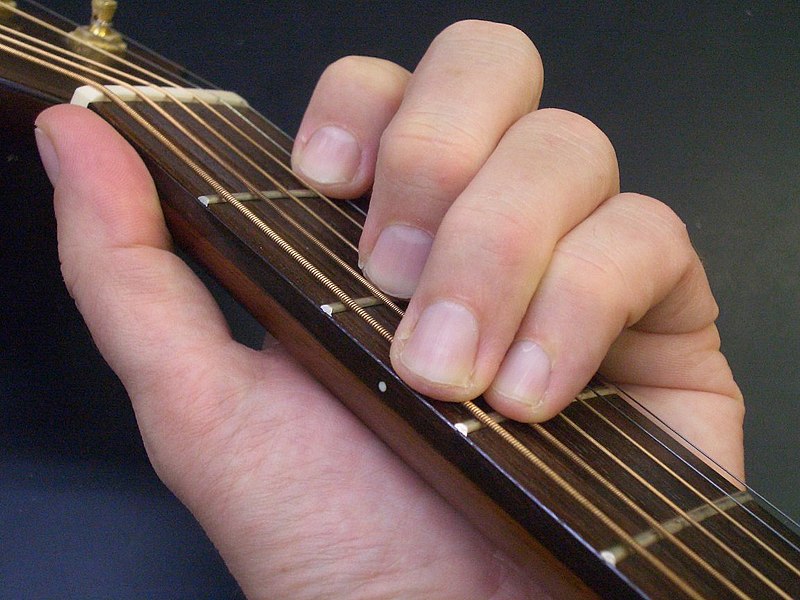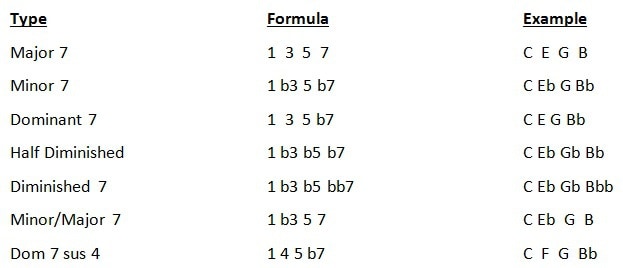Have you ever found yourself strumming away on your guitar, only to realize you have no idea what chords you’re actually playing? Don’t worry, you’re not alone. We’ve all been there, fingers contorted into weird shapes, hoping for the best. But fear not, dear reader, for today we are embarking on a journey to unravel the mystery of guitar chord theory. So grab your six-string, pour yourself a cup of coffee (or something stronger, we won’t judge), and let’s dive into the wild and wacky world of chord progressions.
Contents
- 1 The Structure of a Guitar Chord
- 2 Exploring Major Chords: Building Blocks of Music
- 3 Diving into Minor Chords: Expressing Emotion and Depth
- 4 Deciphering Seventh Chords: Adding Layers to Your Sound
- 5 The Circle of Fifths: Mapping Chord Progressions
- 6 Barre Chords: Expanding Your Chord Vocabulary
- 7 Altering Chords: Adding Sus, Dim, and Aug for Variance
- 8 FAQs
- 9 Strumming Off into the Sunset
The Structure of a Guitar Chord
Ever wonder what actually makes up a guitar chord?
Well, let me break it down for you in a way that even your grandma could understand.
- Root Note: This is the note that gives the chord its name. It’s like the captain of the chord ship, steering the rest of the notes in the right direction.
- Third: The third is like the sidekick to the root note, adding that extra bit of flavor to the chord. You can think of it as the salt to the root note’s pepper.
- Fifth: The fifth is the backbone of the chord, providing stability and structure. It’s like the trusty sidekick that always has your back.
So there you have it, the basic structure of a guitar chord. Next time you’re strumming away on your guitar, just remember that behind every beautiful sound is a carefully crafted chord waiting to be played.

Exploring Major Chords: Building Blocks of Music
Have you ever wondered what makes music sound so harmonious and pleasing to the ear? Well, look no further than major chords! These magical combinations of notes are the building blocks of music, the secret sauce that makes your favorite songs sound so darn catchy.
Major chords are like the peanut butter and jelly of the music world – they just go together perfectly. Made up of three notes – the root, the major third, and the perfect fifth – major chords have a bright and cheerful sound that can instantly lift your mood.
Think of major chords as the superhero trio of the music universe, swooping in to save the day with their harmonious blend of frequencies. When you play a major chord, it’s like a burst of sunshine on a rainy day, a ray of musical light shining down on your ears.
So, the next time you’re jamming out on your guitar or tickling the ivories on the piano, take a moment to appreciate the humble major chord. It may just be a simple combination of notes, but it’s the foundation of all the music that brings joy to your life.

Diving into Minor Chords: Expressing Emotion and Depth
Minor chords, oh the drama they bring! It’s like adding a dash of salt to a bland dish – it instantly elevates the flavor and gives it depth. In the world of music, minor chords are the spice that adds emotion and complexity to a piece.
When you play a minor chord, you’re tapping into a whole new range of feels. It’s the musical equivalent of that moody teenager who sulks in their room all day – deep, brooding, and full of emotion. So if you want to convey feelings of sadness, longing, or melancholy in your music, minor chords are your go-to.
But don’t be fooled, minor chords aren’t just about sadness and despair. They also have the power to express a sense of mystery, tension, or even a hint of danger. It’s like adding a twist to a classic tale – suddenly, the plot thickens, and you’re hooked, wondering what’s going to happen next.
So next time you sit down at the piano or pick up your guitar, don’t shy away from those minor chords. Let them take you on a journey of emotion and depth, where every note is a brushstroke on the canvas of your musical masterpiece. Embrace the darkness, and watch as your music comes alive in unexpected ways.

Deciphering Seventh Chords: Adding Layers to Your Sound
If you’re tired of your music sounding one-dimensional and want to add some depth to your sound, look no further than seventh chords! These bad boys are like adding a cherry on top of your ice cream sundae – that extra layer of flavor that takes your music from basic to boujee.
Seventh chords are like a secret sauce that injects some spicy flavor into your otherwise bland chord progressions. They add a hint of tension and intrigue that keeps your listeners on their toes, wondering what musical twist you’ll throw at them next.
With seventh chords, you can unleash your inner mad scientist and experiment with different combinations to create your own signature sound. Mix and match major, minor, and diminished chords with their respective sevenths to elevate your music to the next level.
So why settle for plain old triads when you can amp up your sound with the magic of seventh chords? Dive in, experiment, and watch as your music transforms from mediocre to magnificent. Your ears (and your fans) will thank you!

The Circle of Fifths: Mapping Chord Progressions
Have you ever felt lost in a sea of chord progressions, unsure of how to navigate your way through the musical journey? Well, fear not, because the Circle of Fifths is here to save the day! This mystical wheel of musical wisdom will guide you through the treacherous waters of chord progressions, helping you to make sense of the chaotic world of music theory.
With the Circle of Fifths as your trusty sidekick, you’ll be able to easily map out complex chord progressions and create harmonious melodies that will leave your audience in awe. No longer will you find yourself wandering aimlessly through a maze of chords, unsure of where to go next. The Circle of Fifths will show you the way, pointing you in the right direction and helping you to unleash your inner musical genius.
So, what are you waiting for? Dive into the magical world of the Circle of Fifths and unlock the secrets of chord progressions like never before. Say goodbye to confusion and hello to musical enlightenment. With the Circle of Fifths by your side, the possibilities are endless!
Barre Chords: Expanding Your Chord Vocabulary
So you’ve mastered those basic open chords and you’re ready to take your guitar playing to the next level with some barre chords. These bad boys can be a bit tricky at first, but once you get the hang of them, you’ll have a whole new world of chord possibilities at your fingertips.
Barre chords involve using one finger to press down multiple strings at once, creating a full, rich sound. They’re like the swiss army knife of guitar chords – versatile and essential for any serious player.
Here are a few tips for expanding your chord vocabulary with barre chords:
- Practice your finger strength – barre chords can be a real workout for your hand, so make sure you’re building up those muscles to avoid cramps and fatigue.
- Experiment with different chord shapes – once you’ve got the hang of the basic barre shapes, try moving them around the neck to create new sounds and textures.
- Don’t be afraid to make mistakes – learning barre chords is a process, and you’re bound to hit a few sour notes along the way. Embrace the imperfections and keep practicing.
So grab your guitar, get those fingers limbered up, and start incorporating some barre chords into your playing. Before you know it, you’ll be wowing audiences with your expanded chord vocabulary and killer sound.
Altering Chords: Adding Sus, Dim, and Aug for Variance
So you’ve mastered the basic chords, but now you’re feeling a bit bored with your playing. Fear not! We’ve got some tricks up our sleeve to add a little spice to your music.
First up, we have sus chords. These babies are like the rebellious teenagers of the chord family. They don’t play by the rules and love to add a bit of tension to your music. Try swapping out a regular chord for a sus2 or sus4 and watch your music come alive.
Next, we have dim chords. Don’t be fooled by their name – they may sound a bit gloomy, but dim chords can add a touch of sophistication to your playing. Experiment with swapping out a regular chord for a diminished chord and see how it changes the mood of your music.
Lastly, we have aug chords. Augmented chords are like the quirky, eccentric cousins of the chord family. They add a touch of unpredictability and can really grab your listener’s attention. Swap out a regular chord for an augmented chord and watch your music take on a whole new dimension.
FAQs
Why do I need to understand guitar chord theory?
Well, if you want to level up your guitar game from ”Wonderwall” to ”Stairway to Heaven”, understanding chord theory is key. It’s like having the cheat codes to unlock the next level of musical awesomeness.
How do I build guitar chords using theory?
Imagine you’re a mad scientist in a lab, mixing and matching different musical elements to create the perfect chord. With chord theory, you’ll know which notes to add, subtract, or tweak to achieve that sweet, sweet harmony.
What’s the deal with major and minor chords?
Think of major chords as your happy-go-lucky buddy who always sees the glass as half full. Minor chords, on the other hand, are more like your brooding poet friend who writes angsty love songs in their journal. Understanding the differences between these two can help you set the mood in your music.
How can guitar chord theory improve my improvisation skills?
Picture this: you’re jamming with your friends, and suddenly it’s your turn to shine with a killer solo. By understanding chord theory, you’ll be able to navigate the fretboard with confidence, knowing exactly which notes will make your guitar sing.
Is there a shortcut to learning guitar chord theory?
Well, if you happen to stumble upon a magical guitar genie who can grant your musical wishes, then sure, that’s a shortcut. But for us mere mortals, the best way to master chord theory is through practice, patience, and maybe a sprinkle of fairy dust for good luck.
Strumming Off into the Sunset
And there you have it, dear reader – the essential foundation of guitar chord theory laid out before you like a perfectly tuned instrument. Armed with this knowledge, you’ll be able to strum your way through any song with confidence and flair. So go forth, budding rockstar, and let the chords be your guide as you embark on your musical journey. And remember, when in doubt, just play it loud and proud – after all, who needs theory when you have the power of rock on your side? Happy strumming!



